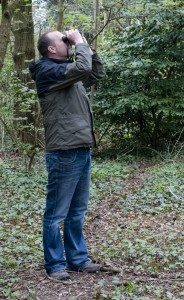We’ve been lucky enough to secure the services of Paul and Ian to undertake a bird ringing exercise to show the schools’ groups we have coming to the Friday session of the BioBlitz.
It’s such a big site, with so much varied habitat that Paul asked if he could come to the estate, have a bit of a wander around and find a good spot for the ringing session.
The ideal location, Paul told me, is somewhere with relatively low vegetation (like hedges) so that when they put up the catching nets, the birds are more likely to fly into them, rather than over them.
I was a bit worried about these nets – they’re made of black fibres so the birds can’t see them but Paul reassured me they’re soft and they don’t harm the birds at all. Also, Paul will put them up a little off the beaten track and we’ll make sure there some volunteer marshals around so people walking in the estate don’t accidentally walk into them.
After about 20 minutes walking, we found what might well be the ideal spot. It’s an area of shrubby and wild growth just off the downland area on Kings Weston Hill. It’s sheltered, and quiet but it’s close to an area where Paul and Ian can do the ringing demonstration without having to take the spectators too near the nets.
The birds caught will be identified, measured and their general state of health noted and the data will be added to a bird ringing database as well as our BioBlitz database. The ringing data is very important in helping naturalists identify the state of bird populations, where birds travel and how long they live. All of these things can help us protect species.
Whilst we were walking we heard chiff-chaffs, wrens, robins and plenty of great tits and blue tits. Paul was also convinced he’d heard something a bit rarer and was hoping to hear it again.
Roll on 3rd May!

